
advertisements
NeptuneCafe presents
Pallas, the Goddess of
Creative Intelligence
On this page...
Why Pallas in the natal chart? Pallas and Eleanor Bach, Pallas and the outer planets, Pallas in political astrology, with Henry Kissinger and Caroline Kennedy

The Rise in Feminine Consciousness
In 1993, Ariel Guttman wrote in her excellent book Mythic Astrology, "For the past twenty years or so, Pallas Athena has been one of the most dramatically visible archetypes emerging into Western consciousness." By this, she was referring to Pallas' role in sharpening women's intellectual skills and thrusting them into the patriarchal order with much success. The corresponding shift in men's psyches can be seen in those who have tempered their rational minds and domineering behavior in favor of increased compassion, wisdom, and sensitivity. Obviously, what was true in 1993 is even more so today.
Since Ceres, the first asteroid, was discovered in 1801, the rise of feminine consciousness has proceeded in fits and starts. As was the custom then, the first hundred or so asteroids were named after female deities, reflecting an awareness among astronomers that male deities were over-represented in the cosmic scheme of things. Now that some ten thousand asteroids have been sighted and named, astrologers may wonder how to make sense of this new metaphysical pantheon.
Pallas in Political Astrology
A prominently placed Pallas can make one exceptionally skilled as a political strategist. Pattern recognition, tactical vision, and the instinct to uphold the dominant social order are natural to the Pallas personality. Those with Sun conjunct Pallas tend to become reliable political advisers to the stronger politician. Karl Rove (Bush's adviser), George Stephanopolous (Bill Clinton's adviser), Nancy Reagan (Ronald Reagan's right-hand adviser), and Rahm Emanuel (Obama's adviser) all have Sun conjunct Pallas with an orb of 2º or less. What are the odds?
As a note on political astrology, and underscored by those who write about predictive astrology, outer planet transits combined with secondary progressions provide a first-rate analytical technique. Many astrologers use only transits, which is missing half the developmental potential. While outer planet transits are often used to correlate character with events, secondary progressions describe an inner evolution (or "progress"), which eventually becomes manifest when activated by transits. The first step is to understand the natal configurations. Then watch how they unfold via major progressions and transits. Here's how this works, looking at Henry Kissinger's and Caroline Kennedy's horoscopes – with emphasis on their prominent Pallas placements.
Henry Kissinger
Pallas in Practice
You can extend the value of the Pallas-Jupiter combination to reading charts for yourself or clients. When these two come together by transit or progression, spontaneous, wonderful insights happen. Vision quests are best undertaken when transiting Jupiter is aspecting natal Pallas, for example. Some of life's thorniest problems can be resolved when progressed Pallas aspects natal Jupiter. If one is lucky enough to have a natal Pallas-Jupiter aspect, then any outer planet transit or secondary progression aligned with the natal Pallas-Jupiter can bring resolution to longstanding problems. If you have an issue, then meditate on it as Pallas and Jupiter form connections. Expect synchronicity to strike, and be open to unusual or unconventional solutions. When these two align, we can become aware of a Universal Intelligence that guides and teaches. They renew our faith in cosmic justice and wisdom.
In ancient mythology, Pallas is directly linked to Jupiter. In the earlier Greek version, from which the Roman stories are derived, Pallas is known as Athena. Demetra George, author of the Asteroid Goddesses (initially published in 1984), refers to this goddess as Pallas Athena, as do many astrologers. More recently, it seems that just "Pallas" is the norm. In the myth of her birth, Pallas sprang from Jupiter's head as a full-grown warrior queen, an archetypal scene that gives us many of her meanings. Her primary goddess power is intelligence; she is cerebral, wise, intuitive, visionary, a tactical genius, and interested in promoting justice. Pallas uses her creativity to serve the needs of civilization, which since ancient Greek times, has been a patriarchal order. The Greeks revered her second to only Zeus (Jupiter), and honored her by naming their center of intellectual activity after her – Athens, the birthplace of democracy.

Eleanor Bach, the pioneering astrologer who brought us the first asteroid ephemeris in 1972, had some good insights into this. She promoted the use of the first four asteroids as primary archetypes to be included in horoscopes. By using these four – Ceres, Pallas, Juno, and Vesta – gender balance was restored to the charts' interpretations. And just considering discovery dates, these four also demonstrate a higher order of relevance or interpretive value. Pallas was discovered in 1802, followed by Juno in 1805 and Vesta in 1807. The fifth asteroid, Astraea, wasn't discovered until 1845, and was followed by a flood of additional asteroid sightings.
Until the discovery of Astraea and Neptune in the 1840s, the four new asteroids were generally considered as planets. For example, the 1828 introductory astronomy text First Steps to Astronomy and Geography lists the planets as: "Eleven: Mercury, Venus, the Earth, Mars, Vesta, Juno, Ceres, Pallas, Jupiter, Saturn, and Herschel." (Until the 1850s, Herschel was an alternative name for Uranus, named after its discoverer William Herschel). In 1847 three more asteroids were discovered, and then by 1851 astronomers knew of fifteen. The obvious primacy of the first four asteroids compared to the thousands that came after 1845 is shaped by their shared prominence in the early 19th century, discovery dates, and how well these four carried the awakening feminine archetypes.
Eleanor Bach is sometimes known as "the Mother of the Asteroids", and she personally identified with her Ceres in Scorpio. Her entertaining soirees with good food and asteroid discussions (food for the soul) readily placed her as the personification of Ceres. However, her horoscope (January 11, 1922; 12:17 am; Kulpmont, PA) shows that Pallas is the most prominent asteroid in her chart. Pallas is located at 14º Libra, only a few degrees from her Libra Ascendant and Jupiter at 18º. Eleanor Bach was the epitome of creative intelligence, which are the key words we associate with Pallas. She recognized the value of the asteroids, the problems of classification, and their connection with the women's movement. She developed the system most used today among asteroid lovers, namely deploying the first four in the natal horoscope and leaving the rest for further exploration.
The Pallas-Jupiter combination is uncommonly visionary. For truth seekers, for those who want to discover the mysterious patterns of our universe, and for those interested in seeing into the future, you couldn't ask for a better combination than a Pallas-Jupiter conjunction. Eleanor Bach had all these qualities, which she demonstrated every month in her newsletter Planet Watch. And beyond the visual qualities, Pallas is moved to act, even if it means breaking the mold or going against conventional wisdom. For Ms. Bach, it meant devoting her life to the study of asteroids and disseminating her findings.
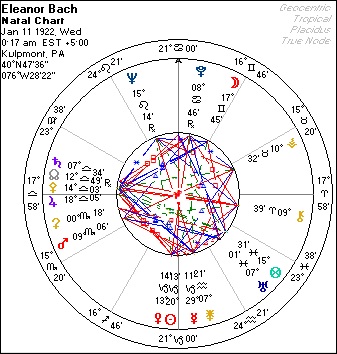
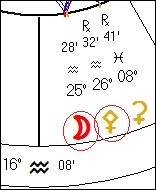
Like the other three major asteroids, Pallas can operate on a purely personal level, or push the individual to participate in the larger social order. The asteroids orbit between Mars and Jupiter, the region that lies between the personal planets and the outer planets. They therefore act as a bridge between personal needs and the collective's needs.
On the purely personal level, a prominent Pallas suggests a close relationship with the father. The father-daughter relationship in particular is represented by Pallas, and often becomes the psychological basis for an instinctive desire to compete in a man's world. The businesswomen dressed in a dapper pantsuit and empowered with her briefcase and cell phone is the modern version of Pallas in full armor with her shield in one hand and sword in the other. This kind of Pallas woman aims to get along with both men and women in the workplace, and avoids any kind of emotional entanglements that could distract from her ambition.
The opposite may also be true, namely, that the Pallas woman fears expressing her intelligence and competitiveness because her personal relationships will suffer. Under stressful aspects, Pallas can be "manly", an unbeatable Amazon, or a people-pleaser, aiming only to keep the peace and becoming a defenseless, helpless girl dependent on her father or partner. Pallas can become adept at rationalizing, at building psychological barriers to protect her from feeling her inner emotional life. At her best, Pallas excels at developing friendships with both sexes. She has found the balance between her head and heart, and between her ambition and her relationships.
Those with Pallas in aspect to the outer planets are especially driven to participate in and shape our social, political, financial and entertainment worlds. In traditional astrology, before Neptune was discovered, Jupiter governed the religious, spiritual side of the psyche. Pallas in aspect to Neptune, like Pallas-Jupiter aspects, has a distinctive feel for the invisible, intangible vibrations that pervade our material world. Neptune's association with glamor, music, and film makes it an ideal aspect to have for those seeking stardom. Tight Pallas-Neptune aspects are often found in celebrity horoscopes. A full 20 percent of the celebrities in my files have Pallas-Neptune aspects with orbs less than two degrees, a statistical aberration that defies chance.
Virtually every well-known religious leader has a close Pallas-Neptune aspect. If Neptune tunes us to the spiritual realm, Pallas brings that awareness back to the civilized, structured world. Pope Benedict has Pallas square Neptune, while Pope John Paul II's chart shows Pallas trine Neptune. John Paul I, who was pope for only one month before dying mysteriously, has an exact conjunction of Pallas and Neptune. Pope John XXIII, the Dalai Lama, Billy Graham, and Mormon founder Joseph Smith all have Pallas-Neptune aspects with orbs less than two degrees.
The list of wanna-be spiritual leaders is also filled with Pallas-Neptune types. David Koresh, Marshall Applegate, and Jim Jones are the most recognizable cult figures who enticed their followers into mass suicide. So hard aspects between Pallas and Neptune can represent individuals who are seriously delusional. Terrorists and suicide bombers generally have a Pallas-Neptune link, since they believe their actions will get them to heaven or are otherwise spiritually condoned. The unabomber and Abu Musab Al Zarqawi are prime examples.
While Neptune awakens Pallas's more ethereal perceptions, Uranus attunes Pallas to the innovative, idealistic, and humanitarian impulses. Pallas-Uranus aspects (especially the conjunction, trine, and sextile) have a genius for seeing how larger systems work, how the individual components come together to create a larger whole. This visual capacity can be used to create new technologies, or to better understand how society, culture, and politics shape our collective reality. The hard aspects can denote the mad genius or artist determined to upset the status quo for the sake of his or her vision. Those with hard Pallas-Uranus aspects can often be called eccentric, or otherwise are best known for their unusual style or cause. George Lucas, avant garde film director and creator of Industrial Light and Magic, has Pallas conjunct Uranus. Mundane astrologer Charles Harvey, who promoted the concept of the Anima Mundi (World Soul), has Pallas rising square Uranus in the tenth house. Chaz Bono (Sonny and Cher's child), who recently completed a sex-change operation, has Pallas square Uranus.
Those with Pallas-Pluto aspects have a palpable charisma or presence, one that influences the people and conditions around them. Pallas-Pluto aspects denote individuals who can change the world, for better or worse. Their insights and perceptions are often intensely applied to their work and in their interactions with the people around them. The hard aspects can signify mental obsessions or sexual complexes related to gender identity. The harmonious aspects suggest the power of the mind and creativity, which can be used for personal advancement or in facilitating collective change. Celebrities with close Pallas-Pluto aspects are readily identified as being extraordinarily intense, and often have an ability to morph into completely different characters. Consider the stage presence and transformative power of Lady Gaga, for example, who has Pallas exactly trine Pluto. Or Charlize Theron, who won an Academy Award for her portrayal of a serial killer – she has Pallas opposite Pluto. Among the men, Kurt Cobain, Robert Blake, Warren Beatty, Colin Farrel, and Al Pacino all have tight Pallas-Pluto aspects.
In the U.S. national horoscope (using the Scorpio Rising chart), Pallas is located at 26º Aquarius – right next to the Moon at 25º Aquarius. The Moon, as symbol for the people's needs, is permanently shaped by Pallas, which may also be referred to as the Goddess of Democracy. The simple phrase
"We the people.." connotes the value system that formed the American system of governance. The U.S. Sun in Cancer (symbolizing the national leadership), works through the Moon, which in turn gains creative intelligence via Pallas. The U.S. Moon-Pallas conjunction can be associated with "American ingenuity", a fondness for all things technological, and a talent for organizing.
Henry Kissinger (May 27, 1923; 5:30 am; Fürth, Germany), Richard Nixon's chief political adviser, was born with his Gemini Sun trioctile (135º aspect) to Pallas (orb: 0º50'). Although we mostly remember Nixon today for his role in the scandalous Watergate affair, he was instrumental in bringing Red China out of its isolation and into the global capitalist system. Today, China is the world's fastest growing economy and will eventually rival the U.S. as the world's premier superpower. Before Nixon initiated "ping-pong diplomacy" with China in the early 1970s, China was a pure example of the communist state. Since then, China has become a capitalist nation in all but name. It's system may more properly be called state capitalism as opposed to the U.S. and European nations which are run as democratic capitalism.
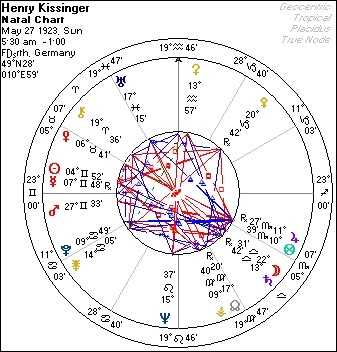

Engaging China diplomatically was a radical idea in 1970. Only since the 2001 declassification of top secret documents has the public become aware of Nixon's efforts. Nixon's invasion of Cambodia made communications with China complex, and they had to be carried out through third party countries. Henry Kissinger was the architect and chief strategist for Nixon's foreign policy. He tried to contact China directly, and through intermediaries in France, Pakistan and Romania, but none of these were successful.
With his Sun in the 12th house, Kissinger became adept at secret deals and behind the scenes negotiations. Nixon directed him to re-double his efforts to contact China in September 1970. At the time, transiting Saturn was going through Kissinger's 12th house, while forming a trine to his natal Pallas.
Kissinger was also in the closure phase of his progressed New Moon: progressed Moon was at 13º Cancer while his Sun was at 20º Cancer. The progressed New Moon would take place in April 1971, and happened to be exactly aligned with his Pallas at 20º Capricorn. Under the auspices of this rare alignment, on April 27, 1971, the ambassador from Pakistan delivered Mao's message that he would be open to receiving Nixon as a visitor. Kissinger then made an unpublicized visit to Beijing to prepare Nixon's historic state visit in January 1971. The Pallas theme in this case is doubled, because Kissinger's progressed Pallas was opposing Pluto. Kissinger's covert diplomatic mission changed the world.
Caroline Kennedy
Like Henry Kissinger, Caroline Kennedy (November 27, 1957; 8:08 am; New York, NY) was also born with her Sun in the 12th house and trioctile Pallas. From the start, her personal identity was entirely wrapped up in the Pallas archetype of being her father's daughter. Pallas is given extra weight in this chart because of its participation in a major configuration: Pallas trines Mercury and opposes Jupiter, and in turn, Jupiter is sextile Mercury. Since these three are all aspecting each other with orbs of less than 1/4 degree, this configuration gains in significance. Plus, Mercury's angular placement on the Ascendant and Jupiter as the ruler of the chart (and prominently placed in the tenth house) make this three-planet configuration a key to chart interpretation and forecasting.

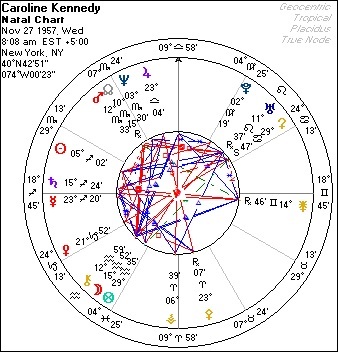
The Mercury-Jupiter-Pallas triangle provides immense vision and intellectual abilities, and includes the ability to articulate clearly. These are her gifts, perhaps inherited, but also developed through trial and error after JFK was assassinated. Another configuration should be mentioned here, and that's the T-square involving Mars, Chiron, and Uranus – all aligned with her karmic lunar node axis. This truly difficult combination has brought Caroline Kennedy more than her fair share of tragedies. Yet through it all, she remains optimistic and hopeful, as characterized by the wisdom and understanding encoded in her Pallas. As an additional tribute to her father, she did not change her name to Caroline Kennedy Schlossberg when she married, but refers to herself as Caroline Kennedy.
In Kissinger's case, Pallas is located in the 8th house. His vision, his ability to recognize patterns was consequently focused on understanding who has what, i.e., other people's resources. Knowing this, he had bargaining chips that could be used to move negotiations this way or that. Caroline Kennedy's Pallas is in the 4th house of the home. Her pattern recognition skills were applied to her family's heritage, which included promoting her father's values through various media and social positions, plus managing her $100 million inheritance. Some of her self-defined duties have included the creation of a Profiles in Courage Award (named in honor of her father's book, Profiles in Courage), being President of the Kennedy Library Foundation, and writing two books that carry on her father's liberal political views.
On January 27, 2008, Caroline Kennedy's editorial supporting Barack Obama appeared in the New York Times. At the time, Hillary Clinton was the leading candidate for the Democrats and the presumed nominee. When Kennedy came out for Obama, the tide turned. This editorial was arguably the turning point in the campaign, and may have tipped the scales in his favor. The op-ed piece was called "A President Like My Father", and gave her endorsement for Obama instead of Clinton. Her concluding lines were: "I have never had a president who inspired me the way people tell me that my father inspired them. But for the first time, I believe I have found the man who could be that president — not just for me, but for a new generation of Americans."
Astrologically, transiting Pallas is not much use since it moves so fast, but progressed Pallas often tells the story. At the time of this pivotal editorial, Kennedy's progressed Sun (her evolving sense of self) was at 26º04' Capricorn. Her progressed Pallas (her evolving creative intelligence) was at 26º00' Aries, only 0º04' past the square to her progressed Sun. Presumably, she conceived the idea and crafted her message while these two were exactly squared.
By the end of 2008, Obama had won the presidency and announced he would name Hillary Clinton to be his Secretary of State. This left her New York senate seat vacant, and Governor Patterson had the sole power to appoint a replacement. Caroline Kennedy announced on December 3, 2008 that she was interested in the job. Over the next seven weeks, her rivals denounced her lack of experience. At the very last minute, as Patterson was scheduled to announce his choice, Kennedy backed out. At 11 pm on January 22, 2009, she withdrew her famous name from consideration, citing "personal reasons". Since then, there's been endless speculation about why she ended her short-lived political career.
From an astrological basis, and using the traditional indicators, she was a clear front-runner and had the seat if she wanted it. Her announcement on December 3 took place as transiting Saturn was trine her Venus, the ruler of her Midheaven. Transiting Jupiter was conjunct her Venus, giving her plenty of enthusiasm and solid prospects. In addition, transiting Pluto was in an empowering trine to her natal Pluto, while transiting Neptune was trine her 10th house Jupiter. Who could ask for anything better? Likewise, her progressed chart showed an energetic thrust forward with her progressed Mars right on her Ascendant. Her progressed Midheaven in Sagittarius was squaring natal Pluto, giving her an incentive to transform her professional life in a meaningful way.
When she pulled out on January 22, all the outer planets were still making their favorable connections. Jupiter had advanced to sextile her Sun, and perhaps she saw the benefit of maintaining a private life rather than a public one. The only challenging progression in effect using the traditional planets was her progressed Ascendant (assuming the rectified time of 8:08 is correct). Her progressed Ascendant was heading into a conjunction with Chiron and the rest of her dangerous T-square. Was this enough to cause her to back out? I don't think so, especially with progressed Mars right on her Ascendant giving her all the boldness and determination she could want.
The situation begins to make sense when considering the asteroids. The closest progressed aspect at the time was her progressed Juno octile (45º) to natal Pallas. The orb was exact, 0º00', marking this aspect as the chief indicator for her decision. Juno is about marriage, Pallas is about politics. For many years, outsiders wondered about the health of her marriage with Edwin Schlossberg. Did she have an affair? Did he? The year before the papers had been filled with rumors about their pending divorce, though zero evidence had ever been submitted. Still, the progressions are what they are, and Caroline's political career (Pallas) was sidetracked for reasons associated with her marriage (Juno).
Most likely, she realized the toll her public political life would have on her very private marriage (Juno) and family life (Pallas in 4th). The Pallas woman can be unbeatable, but winning the battle may mean losing those she loves. To corroborate this, astrologers can check out the obvious stresses to their marriage horoscope (July 19, 1986; 3:00 pm; Hyannis Port, Massachusetts). Regarding the mixture of traditional planets with asteroids, Demetra George said it best: "Astrologers need the asteroids because the traditional planets do not and cannot fully explain the issues which are emerging – simply because they are new."
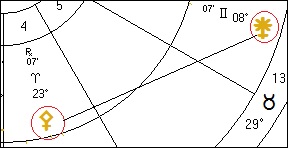

The material on this page is excerpted from April 2011 Dell Horoscope magazine.
The material on this page was written and designed by NeptuneCafe's
resident astrologer,
Michael O'Reilly.
All rights preserved
Part Two - charts how Pallas has changed the lives of six celebrities, arranged as Libra through Pisces.
Part One - Pallas in the signs show's a style of creative intelligence. Here's six celebrity cases: Aries through Virgo.
Pallas Profiles